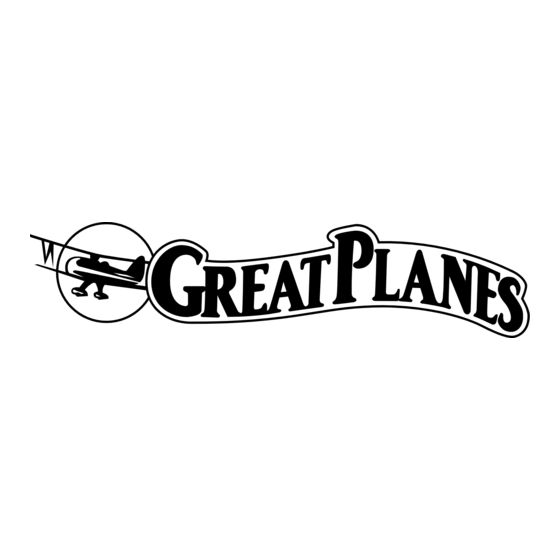GREAT PLANES synapse arf Kullanım Kılavuzu - Sayfa 11
Oyuncak GREAT PLANES synapse arf için çevrimiçi göz atın veya pdf Kullanım Kılavuzu indirin. GREAT PLANES synapse arf 12 sayfaları.

PREFLIGHT
Identify Your Model
No matter if you fl y at an AMA sanctioned R/C club site or if
you fl y somewhere on your own, you should always have your
name, address, telephone number and AMA number on or
inside your model. It is required at all AMA R/C club fl ying sites
and AMA sanctioned fl ying events. Fill out the identifi cation
tag on page 4 and place it on or inside your model.
Charge the Batteries
Follow the battery charging instructions that came with your
radio control system to charge the batteries. You should
always charge your transmitter and motor batteries the night
before you go fl ying, and at other times as recommended by
the manufacturer.
CAUTION: Unless the instructions that came with your
radio system state differently, the initial charge on new
transmitter batteries should be done for 15 hours using
the slow-charger that came with the radio system.
This will "condition" the batteries so that the next charge
may be done using the fast-charger of your choice. If the
initial charge is done with a fast-charger the batteries
may not reach their full capacity and you may be fl ying
with batteries that are only partially charged.
Range Check
Ground check the operational range of your radio before the
fi rst fl ight of the day. With the transmitter antenna collapsed
and the receiver and transmitter on, you should be able to
walk at least 100 feet away from the model and still have
control. Have an assistant stand by your model and, while
you work the controls, tell you what the control surfaces are
doing. Repeat this test with the motor running at various
speeds with an assistant holding the model, using hand
signals to show you what is happening. If the control surfaces
do not respond correctly, do not fl y! Find and correct the
problem fi rst. Look for loose servo connections or broken
wires, corroded wires on old servo connectors, poor solder
joints in your battery pack or a defective cell, or a damaged
receiver crystal from a previous crash.
AMA SAFETY CODE (
Read and abide by the following excerpts from the Academy
of Model Aeronautics Safety Code. For the complete Safety
Code refer to Model Aviation magazine, the AMA web site or
the Code that came with your AMA license.
1) I will not fl y my model aircraft in sanctioned events,
2) I will not fl y my model aircraft higher than approximately
3) Where established, I will abide by the safety rules for the
5) I will not fl y my model unless it is identifi ed with my name
7) I will not operate models with pyrotechnics (any device
1) I will have completed a successful radio equipment ground
2) I will not fl y my model aircraft in the presence of spectators
3) At all fl ying sites a straight or curved line(s) must be
4) I will operate my model using only radio control frequencies
5) I will not knowingly operate my model within three miles
9) Under no circumstances may a pilot or other person touch
)
EXCERPTS
11
General
air shows, or model fl ying demonstrations until it has
been proven to be airworthy by having been previously,
successfully fl ight tested.
400 feet within 3 miles of an airport without notifying the
airport operator. I will give right-of-way and avoid fl ying
in the proximity of full-scale aircraft. Where necessary,
an observer shall be utilized to supervise fl ying to avoid
having models fl y in the proximity of full-scale aircraft.
fl ying site I use, and I will not willfully and deliberately fl y my
models in a careless, reckless and/or dangerous manner.
and address or AMA number, on or in the model. Note:
This does not apply to models while being fl own indoors.
that explodes, burns, or propels a projectile of any kind).
Radio Control
check before the fi rst fl ight of a new or repaired model.
until I become a qualifi ed fl ier, unless assisted by an
experienced helper.
established in front of which all fl ying takes place with the
other side for spectators. Only personnel involved with
fl ying the aircraft are allowed at or in the front of the fl ight
line. Intentional fl ying behind the fl ight line is prohibited.
currently allowed by the Federal Communications Commission.
of any pre-existing fl ying site except in accordance with
the frequency sharing agreement listed [in the complete
AMA Safety Code].
a powered model in fl ight; nor should any part of the
model other than the landing gear, intentionally touch the
ground, except while landing.
CHECK LIST
During the last few moments of preparation your mind may
be elsewhere anticipating the excitement of the fi rst fl ight.
Because of this, you may be more likely to overlook certain
checks and procedures that should be performed before
the model is fl own. To help avoid this, a check list is provided
to make sure these important areas are not overlooked.
Many are covered in the instruction manual, so where
appropriate, refer to the manual for complete instructions.
Be sure to check the items off as they are completed.
